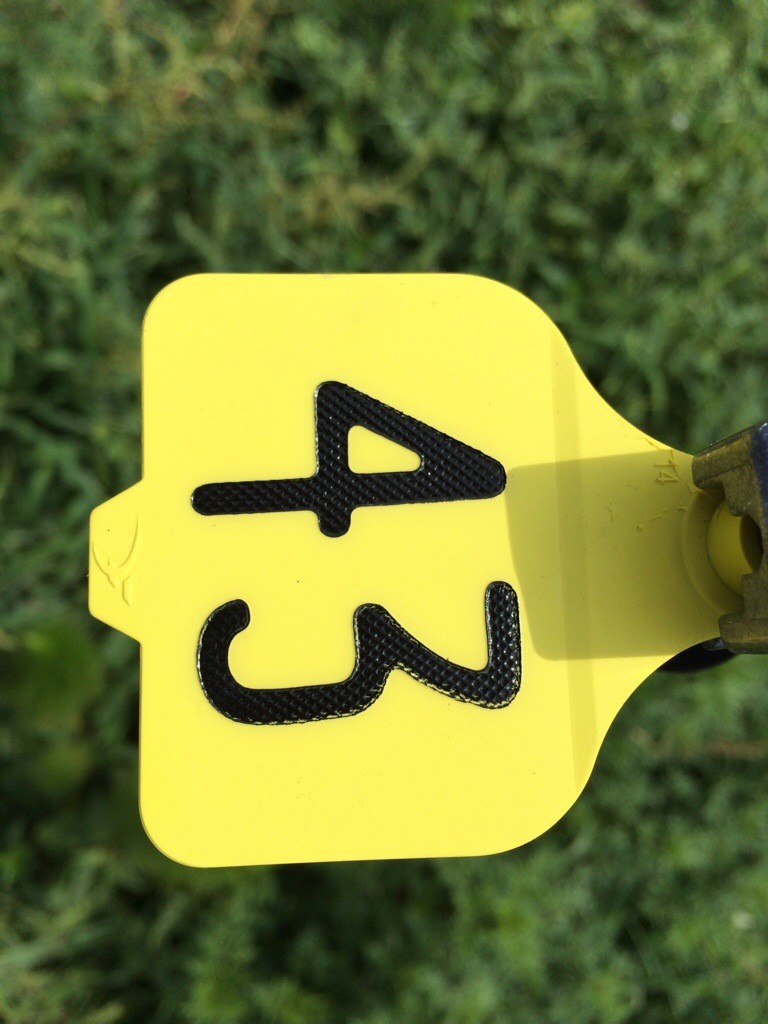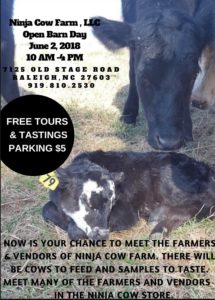
Time: 10 am – 4 pm
Vendor List:
Buck Naked Farm – Lathe Demonstration
*Parking $5, No Dogs Allowed,No Smoking, we encourage carpooling & to come later in the day*
7125 Old Stage Road Raleigh NC 919-322-0197

Time: 10 am – 4 pm
Vendor List:
Buck Naked Farm – Lathe Demonstration
*Parking $5, No Dogs Allowed,No Smoking, we encourage carpooling & to come later in the day*
Dog, cats, ferrets & Soap Crafters, what do they all have in common?
Pork!!!
Dan surprised Jeanette & I today with our special request for
Tails, Fat Back( what you use for lard), Liver, Heart , & Feet are now all in stock in .
Prices
Tails- $4.50 per pound- Not only a great for pets but also great for stews and veggies.
Fat Back $4 per pound if you want lard or to make your own soap this fat is gold.
Liver-$4 per pound liverwurst, Scrapple or liver pudding you know you want to make your own this summer to go with all those fresh garden veggies. We have a few books in the store to steal some recipes out of for these dishes
Heart- $2.99 per pound great for adventurous eaters (slice and cook like a steak) or for pets
Feet- $2.50 per pound. These are my secret ingredient to so many dishes. I smoke them then add them to beans, collards and pork bone broth. Oh yes, pork broth should be its own magical food group.
Ears-$4 per pound. Not just a great dog treat, these are also my favorite bar food. I braise these till tender (280 F in a dutch oven for 2 hours) then slice and fry.
Neck Bone-$4 per pound try a new flavor of bone broth. If you love beans this will add an extra depth of flavor to them.
Finally Raw Goats Milk ($5 per 1/2 gallon) is back in the store on Fridays and Saturdays. The supply will be limited. Please let Lucy know by Monday if you need an order. Several of the area veterinarians in the area have suggested this for orphaned pets or pets going through medical issues such as Chemo or on raw food diets. Please check with your own veterinarians to see if this is right for you.
,
Lucy here on the actual non- recipe part of the blog. We’re still having some internet issues here on the farm. The store is open tomorrow 2-6 p.m. & Satuday from 8-5. Erin & Crystal will be running the store while Dan gives tours. SWMBO & I will be off picking up our kiddos and hosing them down after a full week of sleep away camp.
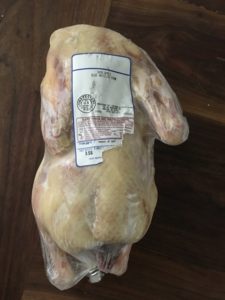
Ninja Cow Farm has a wonderful new product in stock. DUCK!!! Seriously, we now have Duck thanks to Blue Whistler Farm over in Bahama, NC. Blue Whistler is a wife and husband owned 5 acre farm. It may not seem like much land, they work it and are producing some great products.
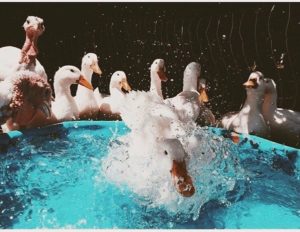
Last year I was introduced to Amy at Blue Whistler Farm. I followed her for a while, light facebook stalking in truth. What drew me to her was the amount she loved and cared for her animals while they were on the farm. How she is able to provide with love and care yet realize this is a business and you must follow the rules of it to be successful.
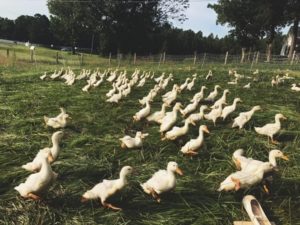
She has tried several animals on her 5 acre farm. Amy shares her triumphs and successes along the way. Now we can share her ducks with you. Blue Whistler Ducks are pastured raised, while receiving conventional feed rations.
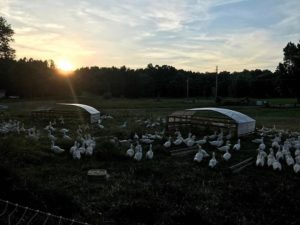
As you can see though they stay in the pasture not in a closed in cage on a factory farm. Amy is hoping this winter to bring us Duck by the cut as well. Blue Whistler ducks are currently sold whole in our store for $8.45lb. Drop by and see us for a new flavor on your table.
Great news just in time for the weekend. Weeping Radish dropped by this morning and delivered Uncured Hot Dogs, Beer Bratwurst, & Linguiça. Hopefully next week they will have our Pastrami & Roast Beef ready for delivery.
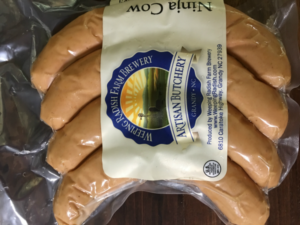
Hot dogs $7 lb 4 per pack in pork casing
Linguica $10.50 lb
Beer Bratwurst $10.50lb
We’ll be sampling the new products this weekend, stock up for Memorial Day cookouts.
We recycle more than we actually farm around here. If you’ve been on a tour, you’ve heard me drone on about what we do, 7 million pounds of produce diverted from the landfill, two truck loads of pallets per month, 16,000 pounds of cardboard per month. Blah, blah, blah.
These numbers are estimates and averages. We know a box of food for the pigs weighs about 1000 pounds when full. We “know” because I know when the tractor starts tipping from being overloaded. Is it really 1000 pounds? I don’t know. Maybe it’s 900, maybe it’s 1100. Heck maybe it’s 1400 pounds. It’s not like I’ve actually weighed the thing. There is only one item that we weigh regularly and that is the cardboard.
Once per month, I take our big trailer and load 10 bales of cardboard, which should weigh about 16,000 based on the first few times we took cardboard to the recycler. That’s where the 16k per month number comes from. I take the truck and trailer over to the recycler off Poole Road and drive the entire rig across the scales where I’m weighed before and after unloading. After I get done, I receive a weigh ticket, that looks like this.

First you see our gross weight as we go across the scales inbound. That’s 40,460 pounds! Yikes that is heavy. This is why I insist on excellent brakes on our equipment. Then we see our Tare weight or empty weight of 18,400. The difference in these two weights is what the 10 bales of cardboard weigh. That weight for this load is 22,060 pounds! So much for 16,000 pounds per month. In fact, the last three tickets have averaged 19,773 pounds! That means that we are recycling, at this run rate, almost a quarter million pounds of cardboard annually! All of this cardboard previously went into the landfill along with the produce so this is true change for the environment.
This 250,000 annual pounds of cardboard is in addition to the 7 million pounds of produce we are recycling annually. And the 6 truck loads of plastic totes annually. And the 1000 yards of chips that we receive from tree companies annually for using in the pig paddocks. The chips were going to the landfill as well. And the various wood totes, boxes, etc. We don’t even count them.
I guess this might explain why I’m speaking at the FoodCon 2016 Food Waste panel at NC State in November. Looking at everyone else on the schedule, I don’t think I’m qualified. But looking at what we are doing, it looks like I might fit in. We’ll see. Hanging around academics and government types isn’t my usual day. I will have to remember to behave. And wear non-farmer clothes.
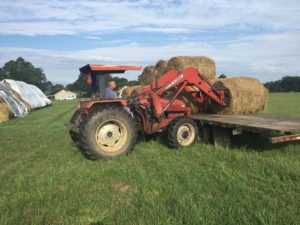
This past week, I picked up our first load of hay for the winter. This is the first of about 140 bales of hay we’ll bring to the farm this fall in preparation for winter munchies. Our cows are grass fed and grass finished so besides the green growing grass we have currently, this is what they get all winter. I get the vast majority of my hay from one farmer in Clayton but Dan the Hay Man, pictured above, had some cow hay he was willing to let me purchase again this year so I grabbed a load while he still had some available. This is a good deal because Dan only grows horse hay (a higher quality hay) but occasionally he’ll have a bit of hay that wasn’t just perfect, making it great for cows (they are less finicky).
The trick with getting hay to the farm is:
By the rules above, that means we can get one, maybe two loads of hay every third alternate Tuesday. Since it takes 9 loads of hay to get us through the winter, by my math it takes about two months to get our hay to the farm. That means I’m already behind! Only 120 bales to go.
Ninja Cow Farm is now carrying a wide arrange of lamb products from High Rock Farm and Thistledown Farm. Dan goes to great lengths to search out small farms that meet his standards. He wants clients to get the best flavor of ethically raised, local meat possible.
Imagine tasty lamb as a burger, now as a fancy cheeseburger. This is a meal to impress friends. The grand total for it should ring in under $25 for 4. I served this decadent slider with a small simple salad and vinaigrette. A great way to introduce your kids to a more complex flavor palate without spending $75 at a nice restaurant that serves lamb.
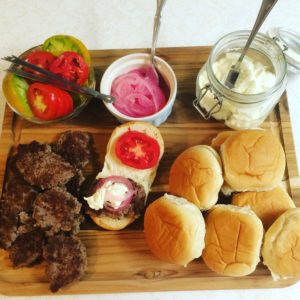
In this recipe, I’m going to teach you how to make Chevre into a condiment called crema. It is a simple way to use a semi-soft cheese, turning it into a spread.
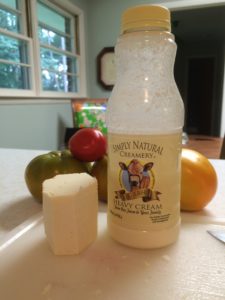
Chevre Cream
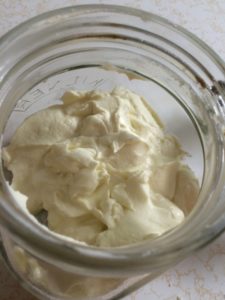
Lamb Slider
These are rich flavors, the best way to not be overwhelmed by them is to add a bit of acid. To do that I added pickled red onion and a garden fresh tomato slice. Ru & my brother added ketchup to theirs. My husband (the short bearded man spotted periodically on the farm) added mustard to his. Lots of ways to dress a slider and none of them are wrong.
For dessert I highly recommend Celebrity Dairy’s Ginger Goat’s Milk Gelato.


A very short article sent to me by SWMBO. Some hobby farmers are fighting a housing development that they don’t want to move in next door.
Not sure about all that’s going on with these people, but I need to find out who made their signs and order some for my farm!
I mentioned Benjamin in this morning’s post and it occurred to me that I had not actually made a post about Benjamin. Benjamin is a bull we purchased last year from a fellow cattleman who was getting out of the business. Benjamin is a Spring Field bull which means he’s a superstar, bred for performance. When we give tours, even people who have no idea about cows remark about Benjamin and how massive he is.
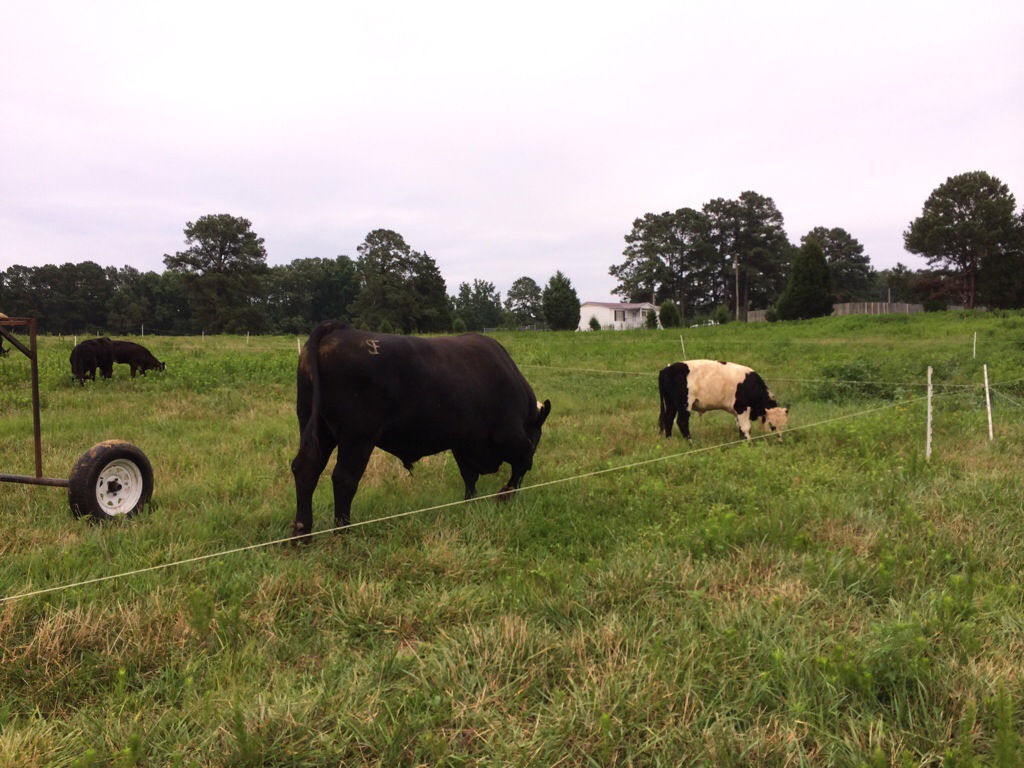
There is a bit of an exaggeration in the above picture because Ben is a bit closer but it’s close enough to get the idea. Benjamin is easily twice the size of the year old steer beside him.
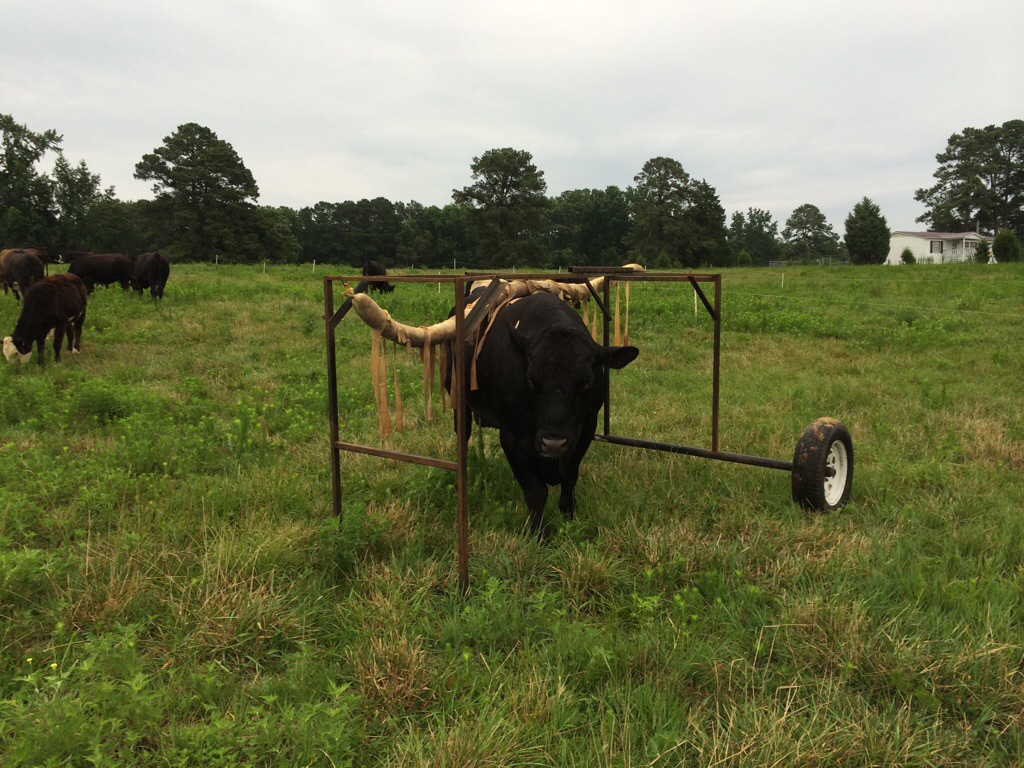
I noted in some previous posts that the flies were especially bad this year. We did do something about it. We built the contraption pictured above, with Benjamin as the Vanna White model. This mobile back scratcher lets the cows rub the areas where the flies congregate and treats them to try to keep the numbers down. In case you’re wondering, the wheels and tires are from the bent axle we replaced on our little trailer. Nothing goes to waste. As you can see Benjamin barely fits under the metal cross bars. The year old calf in the first picture can’t even reach the white part to scratch his back.
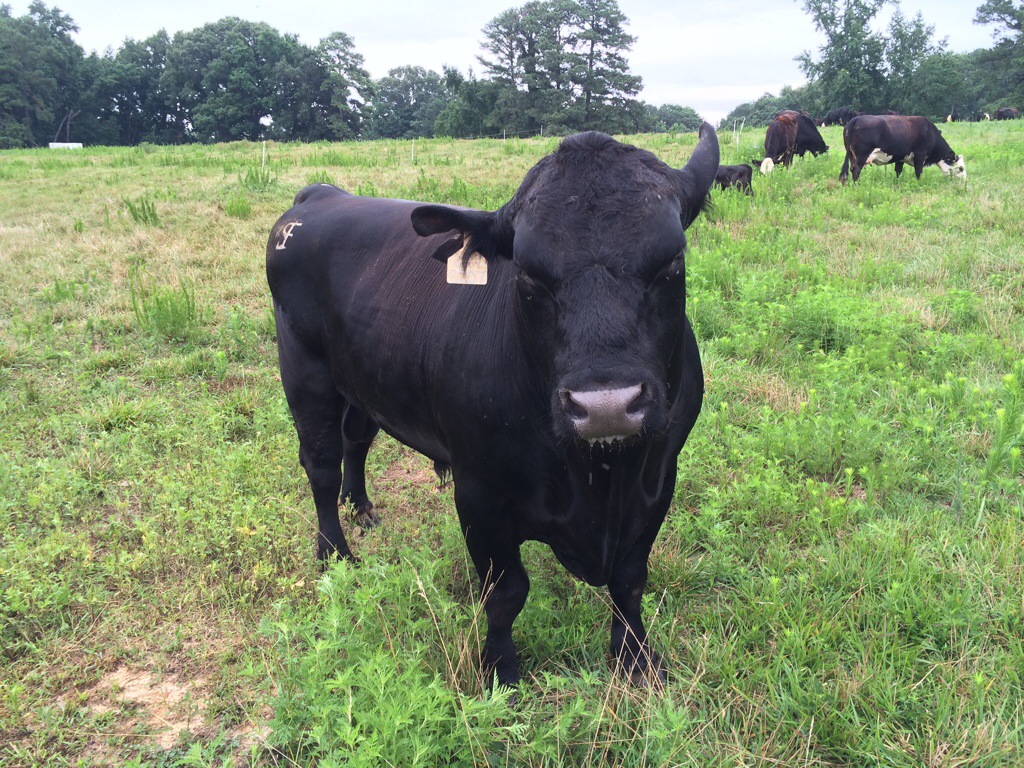
Benjamin is a good bull, and will be with us another 18 months or so before he moves on to a new owner. At that time, Boyd will take over as our herd bull and we will sell of Curious so there’s no incest. That’s assuming father and son can get along for that long.
We’ve really added some nice genetics into our herd with Benjamin and that should continue with Boyd into the future. Boyd likely won’t be the specimen that Benjamin is, but after what happened to Maggie, I think I’ll take a bit smaller bull.
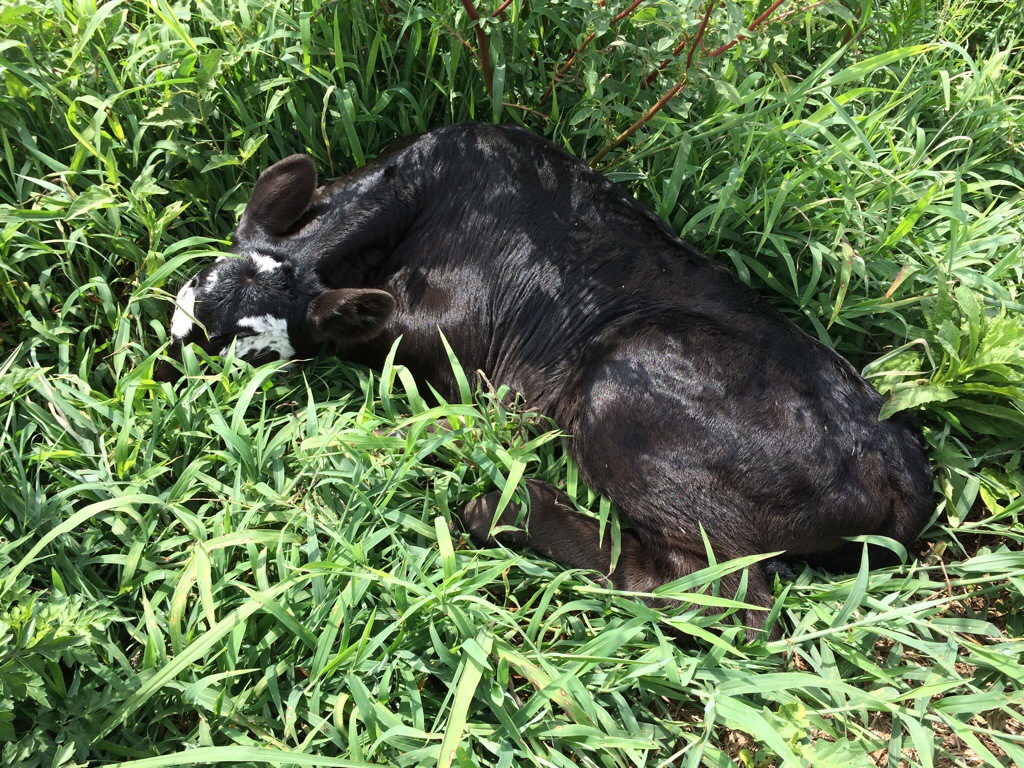
Wednesday of this week we were blessed with another little bull calf here on the farm. This is another Benjamin calf. For those that don’t know, Benjamin is our bull. Benjamin is HUGE and as nice of a bull as you’d want to meet. He eats out of my hand, gentle as a lamb and is usually the last one out of the paddock or to the food when we feed. However every once in a while a bull calf will test him and end up on his butt for the effort, usually after doing a flip or two. He does make some pretty calves though.
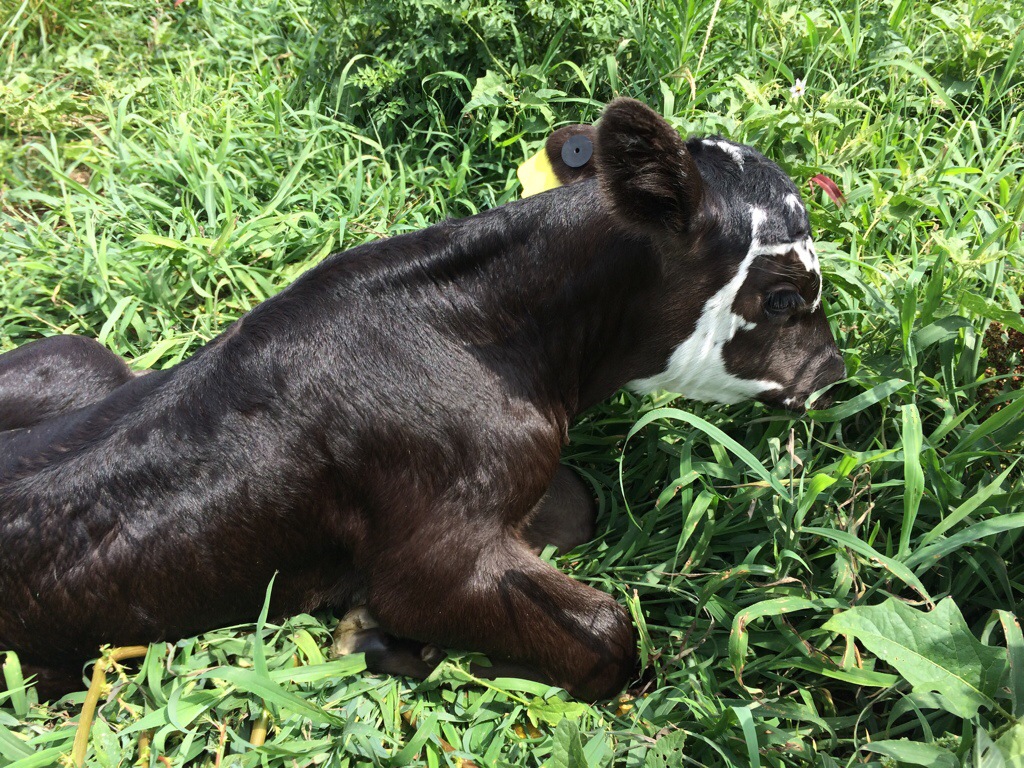
Benjamin is a full-blooded black Angus, with no white markings on him at all. Our cows are baldy Angus, with white faces and some white markings. It’s neat to see the calves which have smaller white markings but Angus shining through.
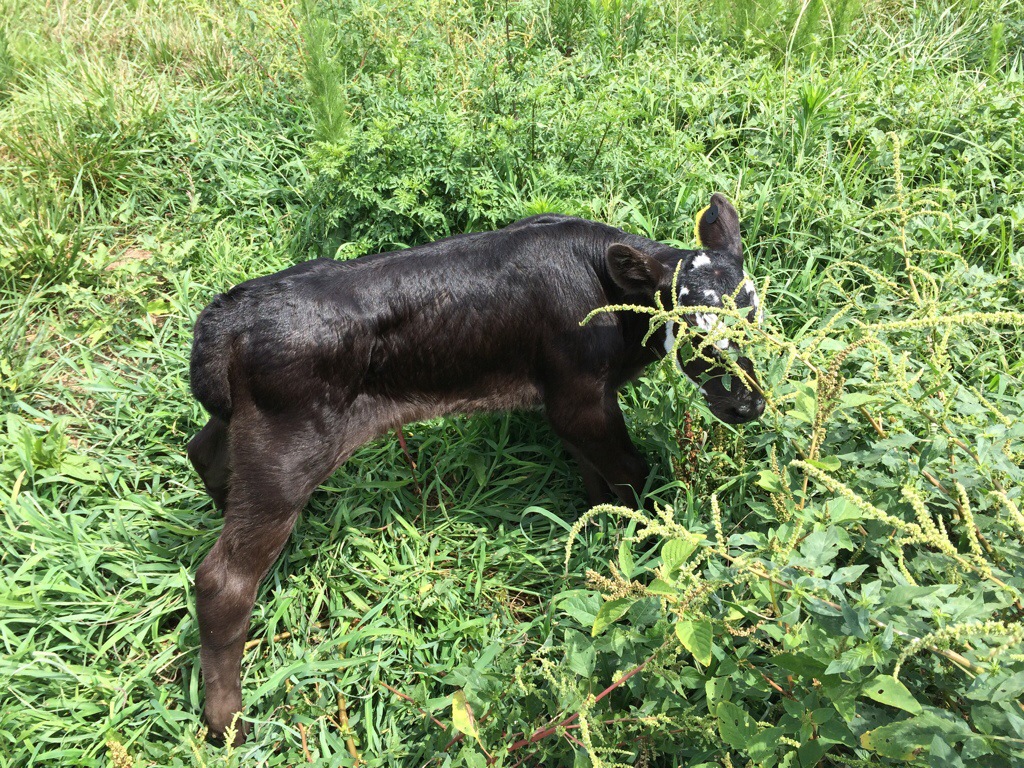
I didn’t want to take too long at this point. We had just ear tagged this calf and banded him (that’s how you castrate them young) so besides being born, he’d already had quite a day. I didn’t want to pose him too.
